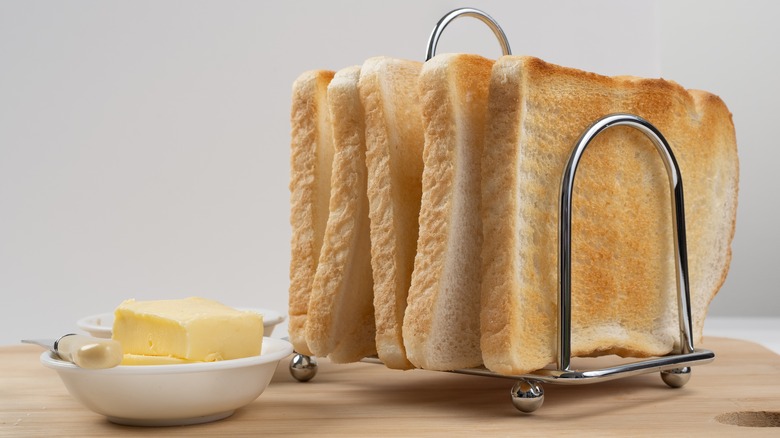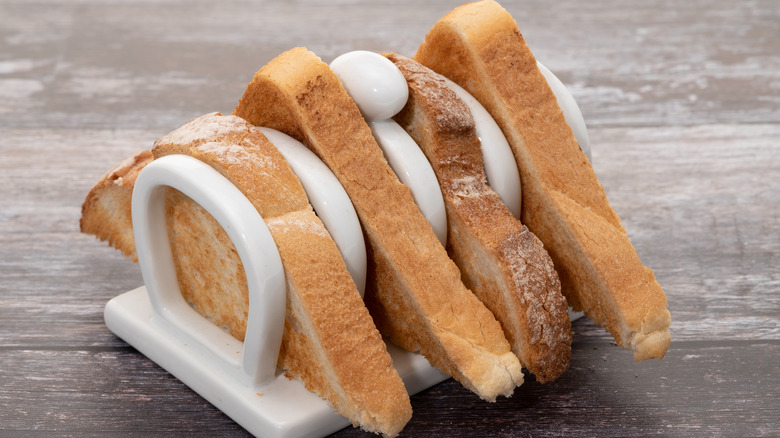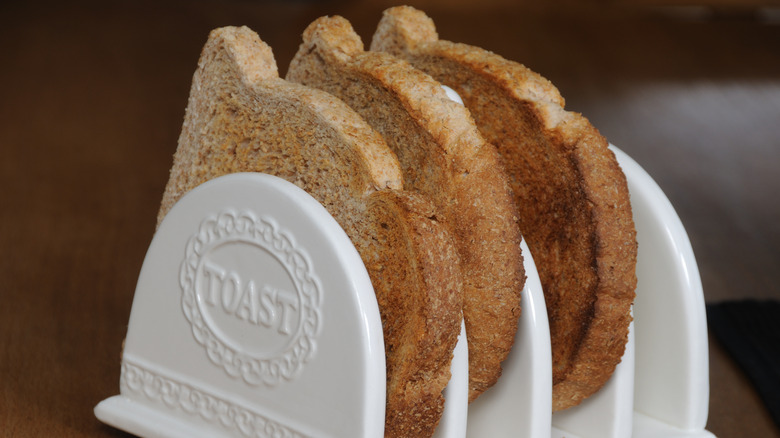The Vintage Kitchen Tool That Prevents Soggy Toast Slices
Many of us love a slice of crisp, lightly-browned toast with butter melting into the hot, crunchy bread. That's why it's so disappointing when your once-crisp toast turns soggy as it sits on a plate. If you can't stand your toast turning out this way while you wait for your eggs and bacon to finish cooking, a neat British-born kitchen tool can help you keep your slices dry and crisp for as long as you like.
You may think that a modern toaster is the be-all end-all of toast-making tools, but the toast rack — which has been sadly left behind by many — deserves a comeback. For the British, toast is something of an obsession, so it's no surprise that the Brits came up with a gadget that keeps slices from getting soggy. When you place hot toast on a plate, the steam released by the bread collects underneath the slice, causing it to turn soft. The toast rack, a metal or ceramic tray with posts, loops, or archways for holding slices of toast and keeping them separate, solves this problem with ease.
The toast rack debuted in Britain in the late 18th century. Today, they're not as common in households, but you can often find them in hotels, where they remain a quintessential English tool for serving breakfast. And if you often cook for a crowd, buying a rack is still an efficient, and very elegant, way to serve perfectly crisp toast at breakfast time.
A toast rack keeps toast slices dry and crispy
The reason why a toast rack preserves your favorite breakfast side dish so well is a simple one. On the rack, each slice of toast is held up vertically, with minimal contact between the bread and the rack itself. This allows air to circulate on all sides of the slices, so steam escapes. Transfer your toast to the rack as soon as each slice is ready, and it will have no chance to become soggy.
One disadvantage of using a toast rack is that the toast will cool down a lot faster, since its heat will evaporate quickly due to the increased air circulation. Your toast might not be especially warm by the time it reaches your plate, but it will retain its desirable crunchiness, which can be a lifesaver when you're toasting far more than one or two slices.
Most toast racks have a simple structure, with a tray underneath to catch crumbs and a handle at the top so the rack can be passed around the table. Some historical models are much more elaborate. If you head to an old-fashioned bed and breakfast in England — or do some shopping in antique stores around the country — you might spot elegant and ornamental models made of gleaming silver. And if you're looking to procure your own simple or fancy toast rack, you have a few options.
Where to get an English-style toast rack
If you don't have a toast rack — and let's be honest, most households don't these days — you can mimic its effect by propping your toast up against an item like a can or jar. This stops the steam making the toast soggy, even if you're making toast from frozen bread. But if you want to get your hands on a rack and serve your breakfast in style, there are several modern stores to buy from.
If you live in England (or just love thrifting), try searching secondhand stores near you for a toast rack. You can also browse Etsy for a selection of racks with an array of unique design options. You can find items from vintage-style silver models to cute ceramic versions. For a toast rack with a classy European feel, look at the kitchenware brand Sambonet, which sells a stainless steel version with curved rings to separate the slices, though it is on the pricey side.
For something more affordable, it's worth looking at Walmart, which offers a range of simple metal or ceramic designs. Amazon also carries a selection of racks, including Victorian-style stainless steel and porcelain models. Or try H&M for a more modern-looking rack in black glazed stoneware. Whichever style you choose, just remember to transfer your hot toast to the rack as soon as it is ready for optimum crunchiness.



